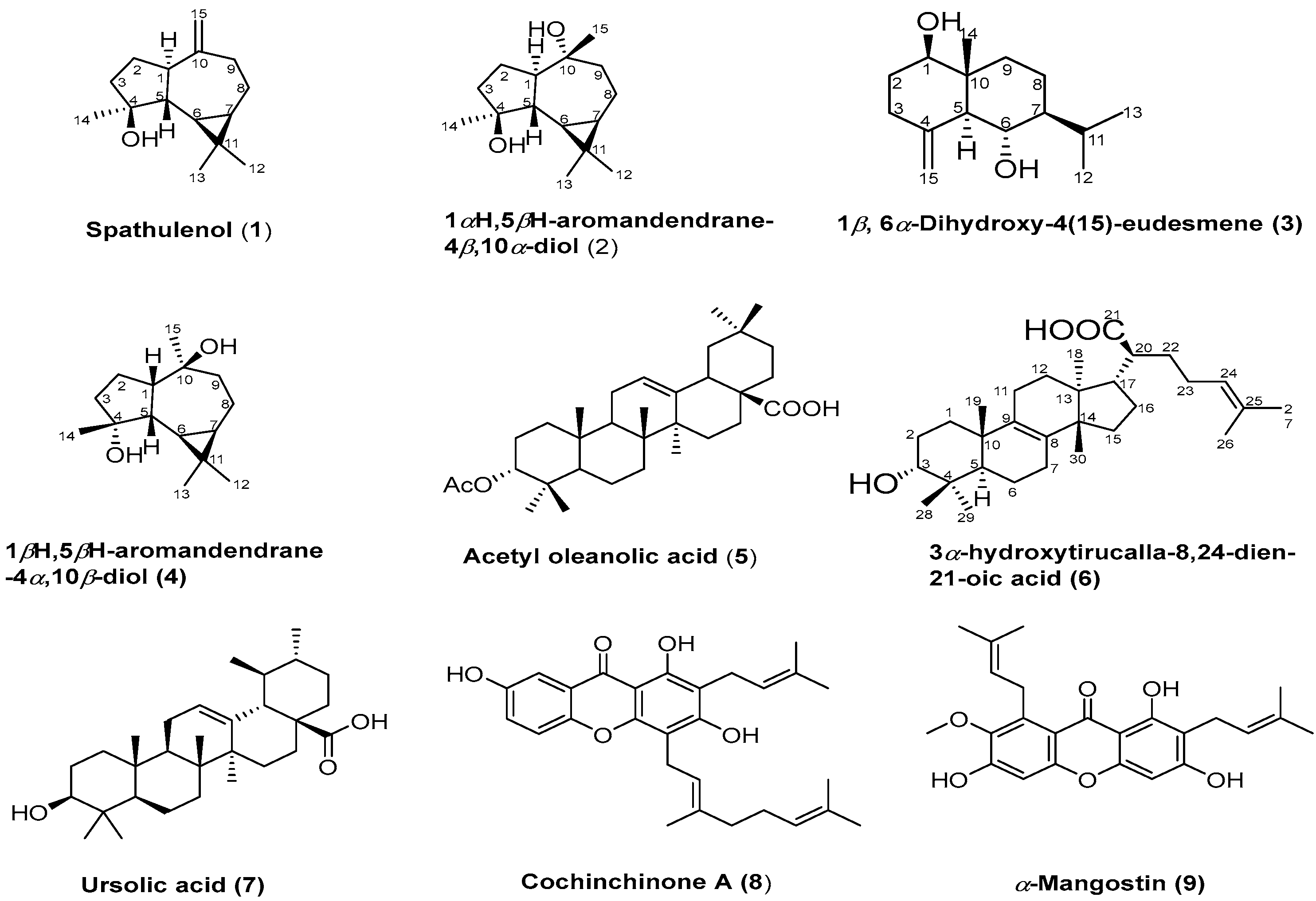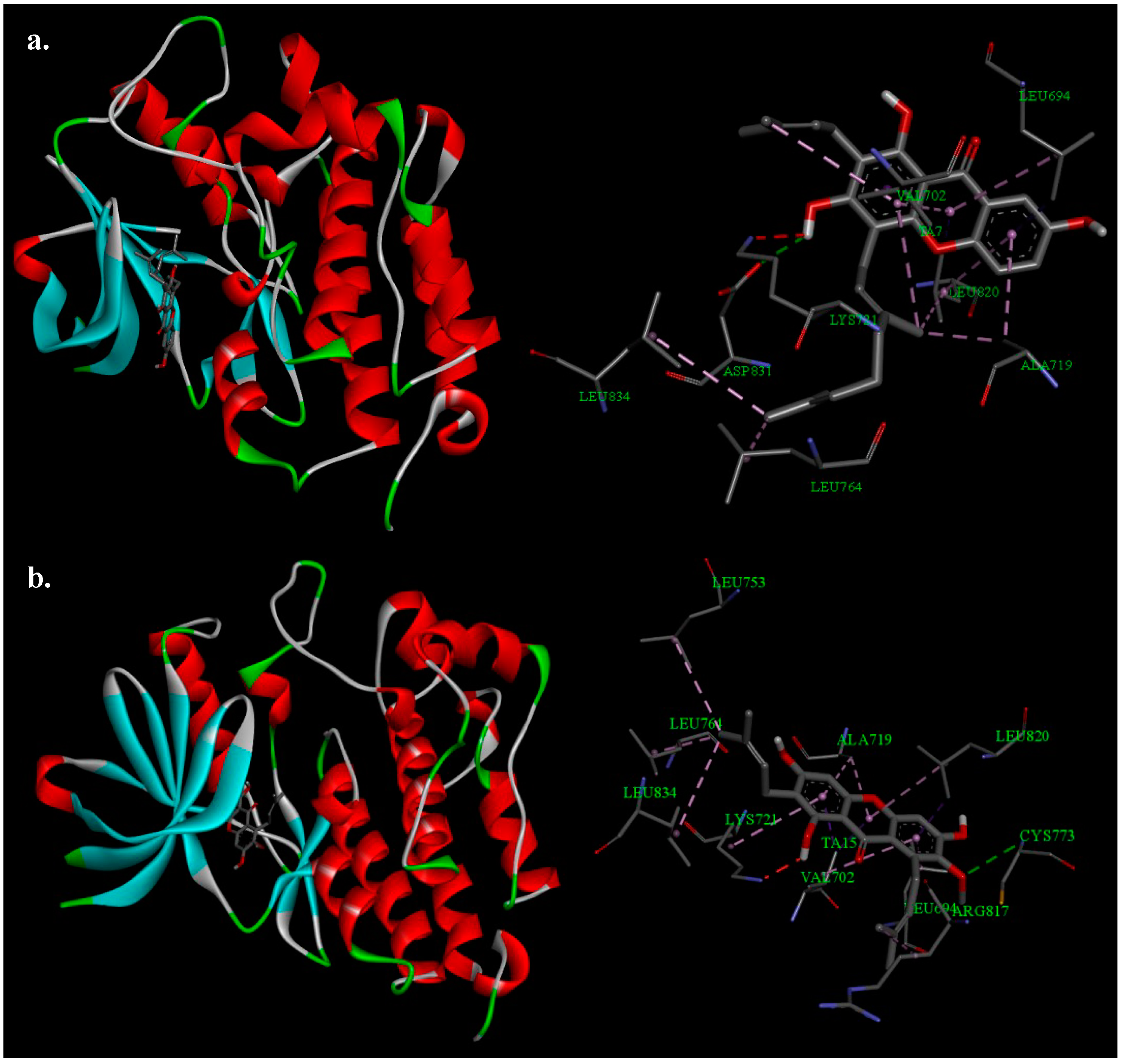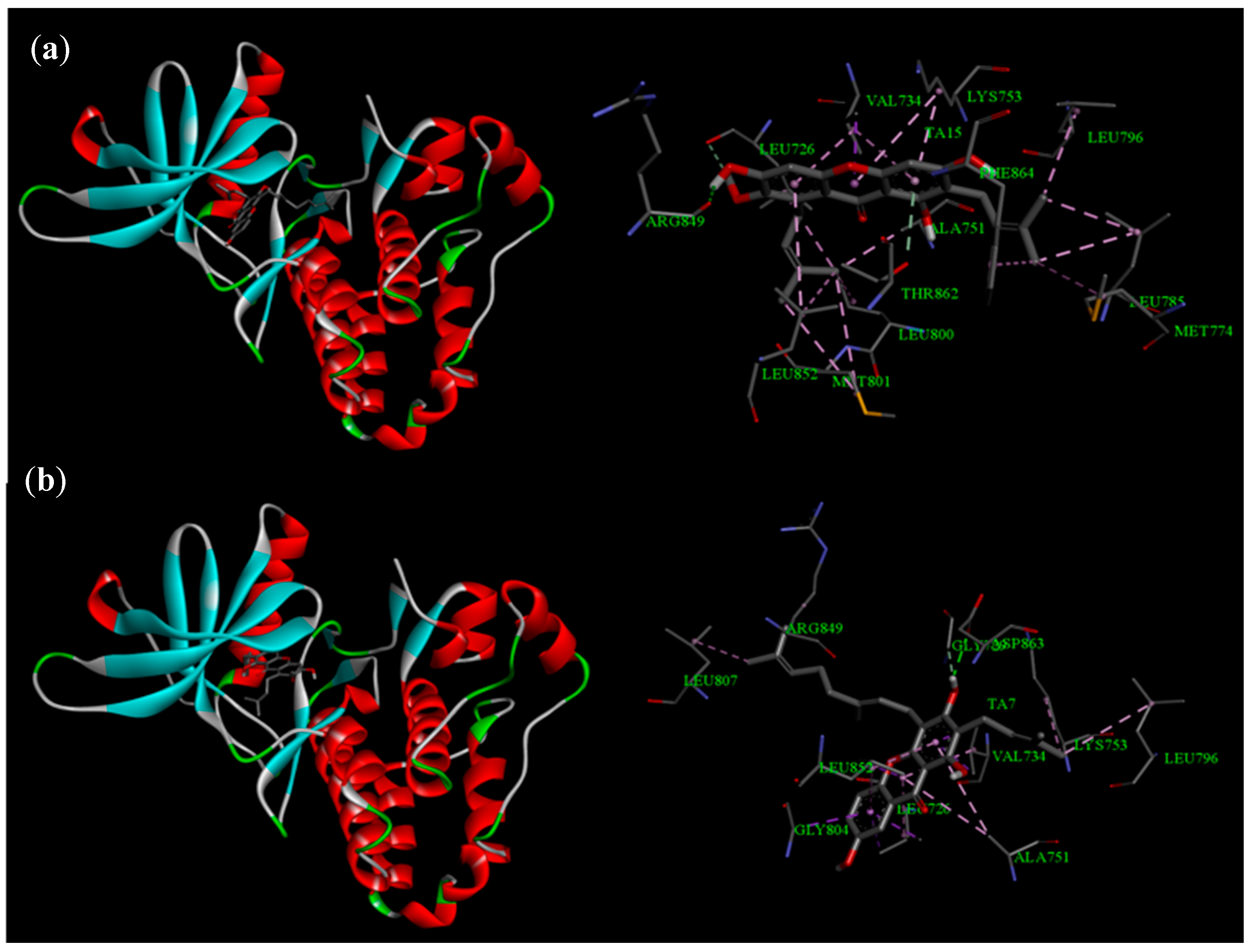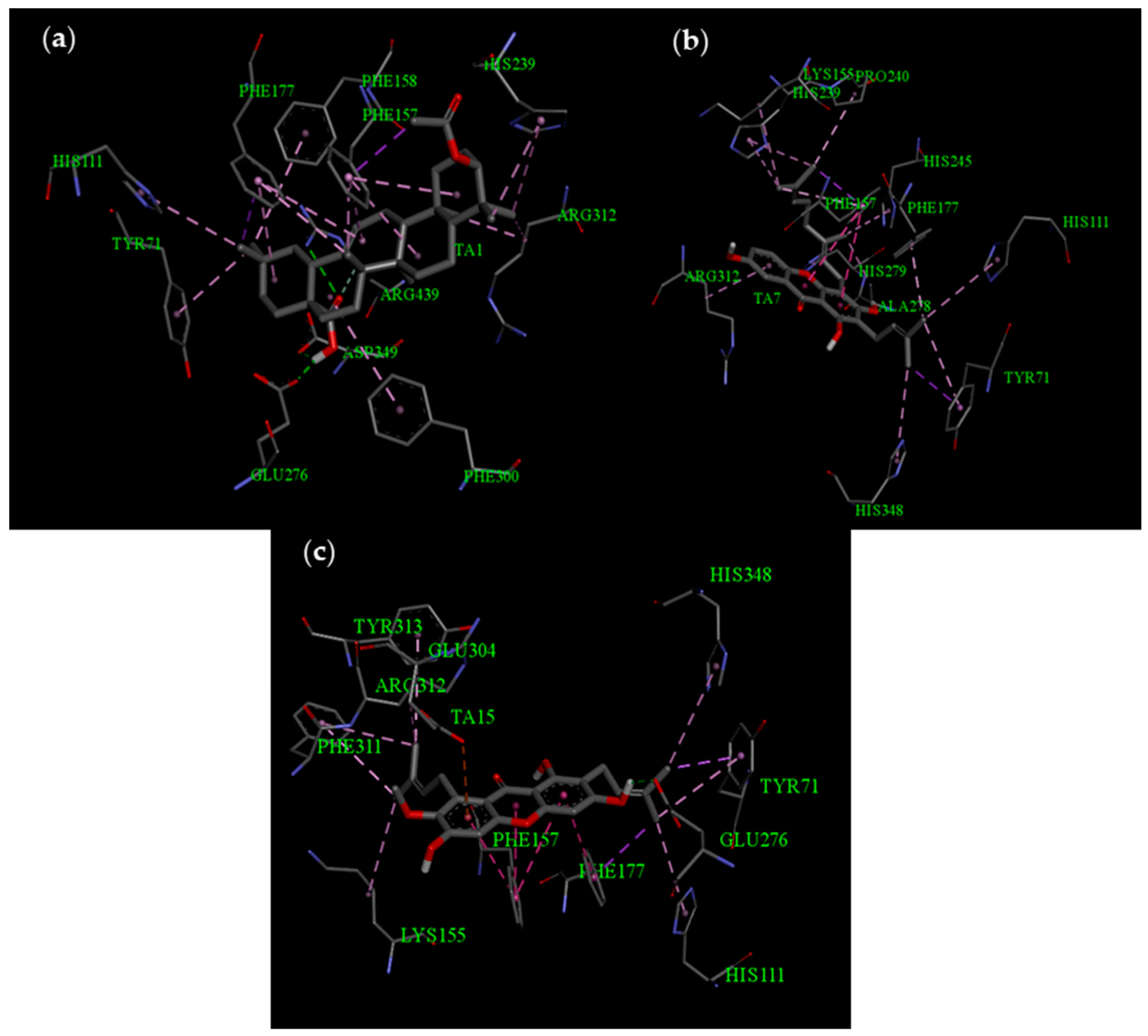Antimicrobial, Cytotoxic, and α-Glucosidase Inhibitory Activities of Ethanol Extract and Chemical Constituents Isolated from Homotrigona apicalis Propolis—In Vitro and Molecular Docking Studies
Abstract
1. Introduction
2. Materials and Methods
2.1. General Experimental Procedures
2.2. Propolis Material
2.3. Extraction and Isolation
2.4. Antimicrobial Activity
2.5. Cytotoxicity Assay
2.6. α-Glucosidase Inhibitory Activity
2.7. Molecular Docking
3. Results and Discussion
3.1. Isolation and Compound Identification
3.2. Antibacterial Activity
3.3. Cytotoxic Activity
3.4. α-Glucosidase Inhibitory Activity
3.5. Molecular Docking
4. Conclusions
Supplementary Materials
Author Contributions
Funding
Institutional Review Board Statement
Informed Consent Statement
Data Availability Statement
Acknowledgments
Conflicts of Interest
Sample Availability
References
- Belmehdi, O.; El Menyiy, N.; Bouyahya, A.; El Baaboua, A.; El Omari, N.; Gallo, M.; Montesano, D.; Naviglio, D.; Zengin, G.; Senhaji, N.S.; et al. Recent advances in the chemical composition and biological activities of propolis. Food Rev. Int. 2022, 1–51. [Google Scholar] [CrossRef]
- Popova, M.; Trusheva, B.; Bankova, V. Propolis of stingless bees: A phytochemist’s guide through the jungle of tropical biodiversity. Phytomedicine 2021, 86, 153098. [Google Scholar] [CrossRef] [PubMed]
- Rasmussen, C. Catalog of the Indo-Malayan/Australasian stingless bees (Hymenoptera: Apidae: Meliponini). Zootaxa 2008, 1935, 1–80. [Google Scholar] [CrossRef]
- Massaro, C.F.; Katouli, M.; Grkovic, T.; Vu, H.; Quinn, R.J.; Heard, T.A.; Carvalho, C.; Manley-Harris, M.; Wallace, H.M.; Brooks, P. Anti-staphylococcal activity of C-methyl flavanones from propolis of Australian stingless bees (Tetragonula carbonaria) and fruit resins of Corymbia torelliana (Myrtaceae). Fitoterapia 2014, 95, 247–257. [Google Scholar] [CrossRef]
- Sanpa, S.; Popova, M.; Bankova, V.; Tunkasiri, T.; Eitssayeam, S.; Chantawannakul, P. Antibacterial compounds from propolis of Tetragonula laeviceps and Tetrigona melanoleuca (Hymenoptera: Apidae) from Thailand. PLoS ONE 2015, 10, e0126886. [Google Scholar] [CrossRef]
- Ragasa, C.Y.; Galian, R.A.F.; Ebajo, V.D., Jr.; Aguda, R.M.; Cervancia, C.R.; Shen, C.C. Propolins and glyasperin A from stingless bee nests. Rev. Bras. Farmacogn. 2015, 25, 177–179. [Google Scholar] [CrossRef]
- Nguyen, H.X.; Nguyen, M.T.; Nguyen, N.T.; Awale, S. Chemical constituents of propolis from Vietnamese Trigona minor and their antiausterity activity against the PANC-1 human pancreatic cancer cell line. J. Nat. Prod. 2017, 80, 2345–2352. [Google Scholar] [CrossRef] [PubMed]
- Zhao, L.; Yu, M.; Sun, M.; Xue, X.; Wang, T.; Cao, W.; Sun, L. Rapid determination of major compounds in the ethanol extract of geopropolis from Malaysian stingless bees, Heterotrigona itama, by UHPLC-Q-TOF/MS and NMR. Molecules 2017, 22, 1935. [Google Scholar] [CrossRef] [PubMed]
- Nguyen, H.X.; Van, D.T.N.; Nguyen, M.T.T.; Dang, P.H.; Tho, L.H.; Awale, S.; Nguyen, N.T. A New alkenylphenol from the propolis of stingless bee Trigona minor. Nat. Prod. Commun. 2018, 13, 69–70. [Google Scholar] [CrossRef]
- Miyata, R.; Sahlan, M.; Ishikawa, Y.; Hashimoto, H.; Honda, S.; Kumazawa, S. Propolis components from stingless bees collected on South Sulawesi, Indonesia, and their xanthine oxidase inhibitory activity. J. Nat. Prod. 2019, 82, 205–210. [Google Scholar] [CrossRef]
- Pujirahayu, N.; Suzuki, T.; Katayama, T. Cycloartane-type triterpenes and botanical origin of propolis of stingless Indonesian bee Tetragonula sapiens. Plants 2019, 8, 57. [Google Scholar] [CrossRef]
- Georgieva, K.; Popova, M.; Dimitrova, L.; Trusheva, B.; Thanh, L.N.; Phuong, D.T.L.; Lien, N.T.; Najdenski, H.; Bankova, V. Phytochemical analysis of Vietnamese propolis produced by the stingless bee Lisotrigona cacciae. PLoS ONE 2019, 14, e0216074. [Google Scholar] [CrossRef]
- Thanh, L.N.; Thoa, H.T.; Oanh, N.T.T.; Giap, T.H.; Quyen, V.T.; Ha, N.T.T.; Hang, N.T.M. Cycloartane triterpenoids and biological activities from the propolis of the stingless bee Lisotrigona furva. Vietnam J. Chem. 2021, 59, 426–430. [Google Scholar] [CrossRef]
- Miyata, R.; Motoyama, T.; Nakano, S.; Ito, S.; Mukaide, K.; Vongsak, B.; Kumazawa, S. Catechol-O-methyltransferase inhibitors isolated from Thai propolis. Nat. Prod. Commun. 2021, 16, 1–5. [Google Scholar] [CrossRef]
- Oanh, V.T.K.; Thoa, H.T.; Hang, N.T.M.; Phuong, D.T.L.; Lien, N.T.P.; Popova, M.; Trusheva, B.; Bankova, V.; Thanh, L.N. New dihydrochromene and xanthone derivatives from Lisotrigona furva propolis. Fitoterapia 2021, 149, 104821. [Google Scholar] [CrossRef] [PubMed]
- Mizuno, S.; Miyata, R.; Mukaide, K.; Honda, S.; Sukito, A.; Sahlan, M.; Taniguchi, T.; Kumazawa, S. New compound from the plant origin of propolis from Lombok, Indonesia and its antibacterial activity. Results Chem. 2022, 4, 100276. [Google Scholar] [CrossRef]
- Hamilton, K.D.; Czajkowski, D.; Kong, N.J.; Tran, T.D.; Gustafson, K.R.; Pauly, G.; Boyle, G.M.; Simmons, J.L.; Steadman, R.; Moseley, R. Anti-Fibrotic Potential of Tomentosenol A, a Constituent of Cerumen from the Australian Native Stingless Bee, Tetragonula carbonaria. Antioxidants 2022, 11, 1604. [Google Scholar] [CrossRef]
- Alanazi, S. Antineoplastic and antitrypanosomal properties of propolis from Tetragonula biroi Friese. Molecules 2022, 27, 7463. [Google Scholar] [CrossRef]
- Arung, E.T.; Syafrizal; Kusuma, I.W.; Paramita, S.; Amen, Y.; Kim, Y.U.; Naibaho, N.M.; Ramadhan, R.; Ariyanta, H.A.; Fatriasari, W.; et al. Antioxidant, anti-inflammatory and anti-acne activities of stingless bee (Tetragonula biroi) propolis. Fitoterapia 2023, 164, 105375. [Google Scholar] [CrossRef]
- Thanh, L.N.; Thu, N.A.; Oanh, V.T.K.; Hue, V.T.; Minh, N.T.; Minh, N.P.N.; Lien, N.T.P. Chemical constituents and cytotoxicity of Lepidotrigona ventralis propolis. Vietnam J. Chem. 2023, 61, 74–79. [Google Scholar] [CrossRef]
- Asem, N.; Abdul Gapar, N.A.; Hapit, N.H.; Omar, E.A. Correlation between total phenolic and flavonoid contents with antioxidant activity of Malaysian stingless bee propolis extract. J. Apic. Res. 2020, 59, 437–442. [Google Scholar] [CrossRef]
- Mohamed, W.A.S.; Ismail, N.Z.; Omar, E.A.; Abdul Samad, N.; Adam, S.K.; Mohamad, S. GC-MS evaluation, antioxidant content, and cytotoxic activity of propolis extract from Peninsular Malaysian stingless bees, Tetrigona apicalis. Evid. Based Complement. Alternat. Med. 2020, 2020, 8895262. [Google Scholar] [CrossRef]
- Mohamed, W.A.S.; Ismail, N.Z.; Muhamad, M.; Omar, E.A.; Samad, N.A.; Ooi, J.P.; Mohamad, S. Q-TOF LC-MS compounds evaluation of propolis extract derived from Malaysian stingless bees, Tetrigona apicalis, and their bioactivities in breast cancer cell, MCF7. Saudi J. Biol. Sci. 2022, 29, 103403. [Google Scholar] [CrossRef] [PubMed]
- Hadacek, F.; Greger, H. Testing of antifungal natural products: Methodologies, comparability of results and assay choice. Phytochem. Anal. 2000, 11, 137–147. [Google Scholar] [CrossRef]
- Mosmann, T. Rapid colorimetric assay for cellular growth and survival: Application to proliferation and cytotoxicity assays. J. Immunol. Methods 1983, 65, 55–63. [Google Scholar] [CrossRef] [PubMed]
- Oanh, V.T.K.; Ha, N.T.T.; Duc, H.V.; Thuc, D.N.; Hang, N.T.M.; Thanh, L.N. New triterpene and nor-diterpene derivatives from the leaves of Adinandra poilanei. Phytochem. Lett. 2021, 46, 110–113. [Google Scholar] [CrossRef]
- Mahnashi, M.H.; Alqahtani, Y.S.; Alyami, B.A.; Alqarni, A.O.; Ullah, F.; Wadood, A.; Sadiq, A.; Shareef, A.; Ayaz, M. Cytotoxicity, anti-angiogenic, anti-tumor and molecular docking studies on phytochemicals isolated from Polygonum hydropiper. BMC Complement. Med. Ther. 2021, 21, 239. [Google Scholar] [CrossRef]
- Tuan, N.N.; Huong, N.T.; My, C.L.T.; Hai, T.X.; Trung, H.T.; Kim, A.N.T.; Tan, T.N.; Van, T.N.; Nguyen, C.Q.; Tran, Q.D.; et al. Inhibition of α-glucosidase, acetylcholinesterase, and nitric oxide production by phytochemicals isolated from Millettia speciosa—In vitro and molecular docking studies. Plants 2022, 11, 388. [Google Scholar] [CrossRef]
- De Magalhães, C.S.; Barbosa, H.J.C.; Dardenne, L.E. A genetic algorithm for the ligand-protein docking problem. Genet. Mol. Biol. 2015, 27, 605–610. [Google Scholar] [CrossRef]
- Ragasa, C.Y.; Ganzon, J.; Hofilena, J.; Tamboong, B.; Rideout, J.A. A new furanoid diterpene from Caesalpinia pulcherrima. Chem. Pharm. Bull. 2003, 51, 1208–1210. [Google Scholar] [CrossRef]
- Qi, S.H.; Wu, D.G.; Ma, Y.B.; Luo, X.D. The chemical constituents of Munronia henryi. J. Asian Nat. Prod. Res. 2003, 5, 215–221. [Google Scholar] [CrossRef] [PubMed]
- Beechan, C.M.; Djerassi, C.; Eggert, H. Terpenoids-LXXIV: The sesquiterpenes from the soft coral Sinularia mayi. Tetrahedron 1978, 34, 2503–2508. [Google Scholar] [CrossRef]
- Lee, K.H.; Min, Y.D.; Choi, S.Z.; Kwon, H.C.; Cho, O.R.; Lee, K.C.; Lee, K.R. A new sesquiterpene lactone from Artemisia rubripes nakai. Arch. Pharm. Res. 2004, 27, 1016–1019. [Google Scholar] [CrossRef]
- Nhiem, N.X.; Tuong, N.T.; Ky, P.T.; Subedi, L.; Park, S.J.; Ngoc, T.M.; Yen, P.H.; Tai, B.H.; Quang, T.H.; Kiem, P.V.; et al. Chemical components from Phaeanthus vietnamensis and their inhibitory NO production in BV 2 cells. Chem. Biodiver. 2017, 14, e1700013. [Google Scholar] [CrossRef]
- Marques, D.D.; Graebner, I.B.; De Lemos, T.L.G.; Machado, L.L.; Assunção, J.C.C.; Monte, F.J.Q. Triterpenes from Protium hebetatum resin. Nat. Prod. Commun. 2010, 5, 1181–1182. [Google Scholar] [CrossRef]
- Seebacher, W.; Simic, N.; Weis, R.; Saf, R.; Kunert, O. Complete assignments of 1H and 13C NMR resonances of oleanolic acid, 18α-oleanolic acid, ursolic acid and their 11-oxo derivatives. Magn. Reson. Chem. 2003, 41, 636–638. [Google Scholar] [CrossRef]
- Mahabusarakam, W.; Nuangnaowarat, W.; Taylor, W.C. Xanthone derivatives from Cratoxylum cochinchinense roots. Phytochemistry 2005, 67, 470–474. [Google Scholar] [CrossRef]
- Li, Z.P.; Song, Y.H.; Uddin, Z.; Wang, Y.; Park, K.H. Inhibition of protein tyrosine phosphatase 1B (PTP1B) and α-glucosidase by xanthones from Cratoxylum cochinchinense, and their kinetic characterization. Bioorg. Med. Chem. 2018, 26, 737–746. [Google Scholar] [CrossRef] [PubMed]
- Milawati, H.; Sukmawati, W.; Harneti, D.; Maharani, R.; Nurlelasari, N.; Hidayat, A.T.; Darwati, D.; Supratman, U.; Shiono, Y. Cytotoxic sesquiterpenoids from the stem bark of Aglaia harmsiana (Meliaceae). Indones. J. Chem. 2020, 20, 1448–1454. [Google Scholar] [CrossRef]
- Benosman, A.; Richomme, P.; Sevenet, T.; Perromat, G.; Hadi, A.H.A.; Bruneton, J. Tirucallane triterpenes from the stembark of Aglaia leucophylla. Phytochemistry 1995, 40, 1485–1487. [Google Scholar] [CrossRef]
- Joycharat, N.; Plodpai, P.; Panthong, K.; Yingyongnarongkul, B.E.; Voravuthikunchai, S.P. Terpenoid constituents and antifungal activity of Aglaia forbessi seed against phytopathogens. Can. J. Chem 2010, 88, 937–944. [Google Scholar] [CrossRef]
- Kurniasih, N.; Milawati, H.; Fajar, M.; Hidayat, A.T.; Abdullah, R.; Harneti, D.; Supratman, U.; Azmi, M.N. Sesquiterpenoids compounds from the stembark of Aglaia minahassae (Meliaceae). Molekul 2018, 13, 56–62. [Google Scholar] [CrossRef]
- Zhang, H.; Xu, H.H.; Sonf, Z.J.; Chen, L.Y.; Wen, H.J. Molluscidal activity of Aglaia duperreana and the constituents of its twigs and leaves. Fitoterapia 2012, 83, 1081–1086. [Google Scholar] [CrossRef]
- Roux, D.; Martin, M.T.; Adeline, M.T.; Sevent, T.; Hadi, A.H.A.; Pais, M. Faveolins A and B, dammarane triterpenes from Aglaia foveolata. Phytochemistry 1998, 49, 1745–1748. [Google Scholar] [CrossRef] [PubMed]
- Ho, P.H. An Illustrated Flora of Vietnam; Youth Publisher: Ha Noi, Vietnam, 1999; Volume 2, pp. 398–405. [Google Scholar]
- Ngo, N.T.; Lai, N.T.; Le, H.C.; Nguyen, L.T.T.; Trinh, B.T.; Nguyen, H.D.; Pham, P.D.; Dang, S.V.; Nguyen, L.H.D. Chemical constituents of Aglaia elaeagnoidea and Aglaia odorata and their cytotoxicity. Nat. Prod. Res. 2022, 36, 1494–1502. [Google Scholar] [CrossRef] [PubMed]
- Vongsak, B.; Kongkiatpaiboon, S.; Jaisamut, S.; Machana, S.; Pattarapanich, C. In vitro alpha glucosidase inhibition and free-radical scavenging activity of propolis from Thai stingless bees in mangosteen orchard. Rev. Bras. Farmacogn. 2015, 25, 445–450. [Google Scholar] [CrossRef]
- An, H.; Thanh, L.N.; Khanh, L.Q.; Ryu, S.H.; Lee, S.; Yeon, S.W.; Lee, H.H.; Turk, A.; Lee, K.Y.; Hwang, B.Y.; et al. Characterization of antioxidant and α-glucosidase inhibitory compounds of Cratoxylum formosum ssp. pruniflorum and optimization of extraction condition. Antioxidants 2023, 12, 511. [Google Scholar] [CrossRef]
- El-Dine, R.S.; Ma, Q.; Kandil, Z.A.; El-Halawany, A.M. Triterpenes as uncompetitive inhibitors of α-glucosidase from flowers of Punica granatum. Nat. Prod. Res. 2014, 28, 2191–2194. [Google Scholar] [CrossRef]
- Kamath, S.; Buolamwini, J.K. Targeting EGFR and HER-2 receptor tyrosine kinases for cancer drug discovery and development. Med. Res. Rev. 2006, 26, 569–594. [Google Scholar] [CrossRef]
- Dokala, A.; Thakur, S.S. Extracellular region of epidermal growth factor receptor: A potential target for anti-EGFR drug discovery. Oncogene 2017, 36, 2337–2344. [Google Scholar] [CrossRef]
- Lurje, G.; Lenz, H.-J. EGFR signaling and drug discovery. Oncology 2010, 77, 400–410. [Google Scholar] [CrossRef] [PubMed]
- Peták, I.; Schwab, R.; Őrfi, L.; Kopper, L.; Kéri, G. Integrating molecular diagnostics into anticancer drug discovery. Nat. Rev. Drug Dis. 2010, 9, 523–535. [Google Scholar] [CrossRef]
- Usman, F.; Shah, H.S.; Zaib, S.; Manee, S.; Mudassir, J.; Khan, A.; Batiha, G.E.S.; Abualnaja, K.M.; Alhashmialameer, D.; Khan, I. Fabrication and biological assessment of antidiabetic α-Mangostin loaded nanosponges: In vitro, in vivo, and in silico studies. Molecules 2021, 26, 6633. [Google Scholar] [CrossRef]
- Wang, Q.; Li, R.; Li, N.; Jia, Y.; Wang, Y.; Chen, Y.; Chen, H. The antioxidant activities, inhibitory effects, kinetics, and mechanisms of artocarpin and α-mangostin on α-glucosidase and α-amylase. Inter. J. Biol. Macromol. 2022, 213, 880–891. [Google Scholar] [CrossRef] [PubMed]
- Cardozo-Muñoz, J.; Cuca-Suárez, L.E.; Prieto-Rodríguez, J.A.; Lopez-Vallejo, F.; Patiño-Ladino, O.J. Multitarget action of xanthones from Garcinia mangostana against α-amylase, α-glucosidase and pancreatic lipase. Molecules 2022, 27, 3283. [Google Scholar] [CrossRef]
- Artanti, N.; Dewijanti, I.D.; Muzdalifah, D.; Windarsih, A.; Suratno, S.; Handayani, S. Alpha-glucosidase inhibitory activity of the combination of Caesalpinia sappan L. and Garcinia mangostana extract. J. Appl. Pharm. Sci. 2023, 13, 189–198. [Google Scholar] [CrossRef]
- Maulana, A.F.; Sriwidodo, S.; Rukayadi, Y.; Maksum, I.P. In silico study of mangostin compounds and its derivatives as inhibitors of α-glucosidase enzymes for anti-diabetic studies. Biology 2022, 11, 1837. [Google Scholar] [CrossRef] [PubMed]
- Nguyen, N.K.; Truong, X.A.; Bui, T.Q.; Bui, D.N.; Nguyen, H.X.; Tran, P.T.; Nguyen, L.H.D. α-Glucosidase inhibitory xanthones from the roots of Garcinia fusca. Chem. Biodiver. 2017, 14, e1700232. [Google Scholar] [CrossRef]
- Ryu, H.W.; Cho, J.K.; Curtis-Long, M.J.; Yuk, H.J.; Kim, Y.S.; Jung, S.; Park, K.H. α-Glucosidase inhibition and antihyperglycemic activity of prenylated xanthones from Garcinia mangostana. Phytochemistry 2011, 72, 2148–2154. [Google Scholar] [CrossRef]
- Kerru, N.; Singh-Pillay, A.; Awolade, P.; Singh, P. Current anti-diabetic agents and their molecular targets: A review. Eur. J. Med. Chem. 2018, 152, 436–488. [Google Scholar] [CrossRef]





| Compound | IC50 (µg/mL) | ||||||
|---|---|---|---|---|---|---|---|
| Gram (+) Strains | Gram (−) Strains | Fungus | |||||
| S. aureus | B. cereus | L. fermentum | S. enterica | E. coli | P. aeruginosa | C. albicans | |
| 1 | >256 | >256 | 205.71 ± 5.23 | >256 | >256 | >256 | >256 |
| 2 | >256 | >256 | >256 | >256 | >256 | >256 | >256 |
| 3 | >256 | >256 | >256 | >256 | >256 | >256 | >256 |
| 4 | >256 | >256 | >256 | >256 | >256 | >256 | >256 |
| 5 | >256 | >256 | 49.88 ± 1.06 | >256 | >256 | >256 | >256 |
| 6 | >256 | 140.8 ± 4.14 | 62.22 ± 1.24 | >256 | >256 | >256 | >256 |
| 7 | 7.10 ± 0.25 | 10.19 ± 0.67 | 10.61 ± 0.70 | >256 | >256 | >256 | >256 |
| 8 | 17.33 ± 0.87 | 7.99 ± 0.33 | 8.67 ± 0.38 | >256 | >256 | 35.44 ± 2.03 | 65.33 ± 3.54 |
| 9 | 0.54 ± 0.07 | 0.57 ± 0.07 | 0.56 ± 0.09 | 16.33 ± 0.78 | 7.89 ± 0.34 | 1.22 ± 0.09 | 0.56 ± 0.06 |
| EtOH extract | 133.1 ± 4.1 | >256 | >256 | >256 | >256 | >256 | >256 |
| A | 0.02 ± 0.005 | 3.62 ± 0.15 | 1.03 ± 0.07 | ||||
| C | 0.43 ± 0.05 | 0.07 ± 0.02 | 4.34 ± 0.15 | ||||
| N | - | - | - | - | - | - | 1.32 ± 0.05 |
| Compound | IC50 (µg/mL) | |||
|---|---|---|---|---|
| KB | A-549 | Hep-G2 | α-Glucosidase Inhibitory Activity | |
| 1 | >128 | >128 | >128 | >256 |
| 2 | >128 | >128 | >128 | >256 |
| 3 | >128 | >128 | >128 | >256 |
| 4 | 89.10 ± 9.67 | >128 | >128 | >256 |
| 5 | >128 | >128 | >128 | 8.44 ± 0.23 |
| 6 | 49.31 ± 5.21 | 78.63 ± 7.69 | 77.71 ± 8.09 | >256 |
| 7 | >128 | >128 | >128 | 25.34 ± 0.54 |
| 8 | 29.27 ± 2.07 | 20.33 ± 1.34 | 17.36 ± 1.03 | 9.07 ± 0.65 |
| 9 | 9.28 ± 0.58 | 7.55 ± 0.25 | 12.90 ± 0.68 | 1.90 ± 0.10 |
| EtOH extract | 124.91 ± 3.05 | 22.82 ± 0.86 | 61.29 ± 1.58 | 146.33 ± 5.04 |
| Ellipticine | 0.48 ± 0.03 | 0.34 ± 0.02 | 0.50 ± 0.03 | |
| Arcabose | 134.56 ± 3.02 | |||
| Compound | Target | Docking Score (kcal/mol) | Interacted Residues |
|---|---|---|---|
| 8 | EGFR | −9.7 | Leu694, Val702, Ala719, Lys721, Leu764, Leu820, Asp831, Leu834 |
| 9 | −9.3 | Leu694, Val702, Ala719, Lys721, Leu753, Leu764, Cys773, Arg817, Leu820, Leu834 | |
| Erlotinib | −7.2 | Leu694, Val702, Ala719, Lys721, Leu764, Gln767, Met769, Leu820, Thr830 | |
| 8 | HER2 | −9.9 | Gly804, Leu726, Leu852, Val734, Ala751, Arg849, Leu807, Gly729, Asp863, Lys753, Leu796 |
| 9 | −9.7 | Val734, Lys753, Thr862, Leu785, Met774, Phe864, Leu796, Met801, Gly804, Ala751, Leu800, Leu852, Leu726, Arg849 | |
| 03Q | −11.2 | Leu852, Leu726, Gly739, Asn850, Thr862, Val734, Leu785, Glu770, Met774, Leu796, Phe864, Lys753, Ala751, Gln799, Met801 | |
| 5 | α-glucosidase | −7.9 | Arg312, Phe177, Tyr71, Phe158, Phe300, Asp349, Arg439, His111, Phe157, His239 |
| 8 | −9.3 | Tyr71, His348, Arg312, Phe157, Pro240, Lys155, His239, His245, His279, Ala278, Phe177, His111 | |
| 9 | −9.9 | Tyr71, His111, His348, Phe177, Glu276, Phe157, Glu204, Arg312, Phe311, Tyr313, Lys155 | |
| Acarbose | −7.6 | Glu304, His279, Pro309, Phe300, Arg312, Glu276, Gln350, Asp349, Tyr313, Asp408, Phe157 |
Disclaimer/Publisher’s Note: The statements, opinions and data contained in all publications are solely those of the individual author(s) and contributor(s) and not of MDPI and/or the editor(s). MDPI and/or the editor(s) disclaim responsibility for any injury to people or property resulting from any ideas, methods, instructions or products referred to in the content. |
© 2023 by the authors. Licensee MDPI, Basel, Switzerland. This article is an open access article distributed under the terms and conditions of the Creative Commons Attribution (CC BY) license (https://creativecommons.org/licenses/by/4.0/).
Share and Cite
Phuong, D.T.L.; Van Phuong, N.; Le Tuan, N.; Cong, N.T.; Hang, N.T.; Thanh, L.N.; Hue, V.T.; Vuong, N.Q.; Ha, N.T.T.; Popova, M.; et al. Antimicrobial, Cytotoxic, and α-Glucosidase Inhibitory Activities of Ethanol Extract and Chemical Constituents Isolated from Homotrigona apicalis Propolis—In Vitro and Molecular Docking Studies. Life 2023, 13, 1682. https://doi.org/10.3390/life13081682
Phuong DTL, Van Phuong N, Le Tuan N, Cong NT, Hang NT, Thanh LN, Hue VT, Vuong NQ, Ha NTT, Popova M, et al. Antimicrobial, Cytotoxic, and α-Glucosidase Inhibitory Activities of Ethanol Extract and Chemical Constituents Isolated from Homotrigona apicalis Propolis—In Vitro and Molecular Docking Studies. Life. 2023; 13(8):1682. https://doi.org/10.3390/life13081682
Chicago/Turabian StylePhuong, Diep Thi Lan, Nguyen Van Phuong, Nguyen Le Tuan, Nguyen Thanh Cong, Nguyen Thu Hang, Le Nguyen Thanh, Vu Thi Hue, Nguyen Quoc Vuong, Nguyen Thi Thu Ha, Milena Popova, and et al. 2023. "Antimicrobial, Cytotoxic, and α-Glucosidase Inhibitory Activities of Ethanol Extract and Chemical Constituents Isolated from Homotrigona apicalis Propolis—In Vitro and Molecular Docking Studies" Life 13, no. 8: 1682. https://doi.org/10.3390/life13081682
APA StylePhuong, D. T. L., Van Phuong, N., Le Tuan, N., Cong, N. T., Hang, N. T., Thanh, L. N., Hue, V. T., Vuong, N. Q., Ha, N. T. T., Popova, M., Trusheva, B., & Bankova, V. (2023). Antimicrobial, Cytotoxic, and α-Glucosidase Inhibitory Activities of Ethanol Extract and Chemical Constituents Isolated from Homotrigona apicalis Propolis—In Vitro and Molecular Docking Studies. Life, 13(8), 1682. https://doi.org/10.3390/life13081682







